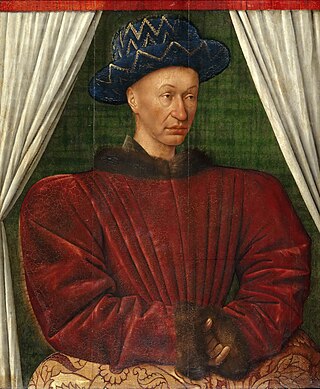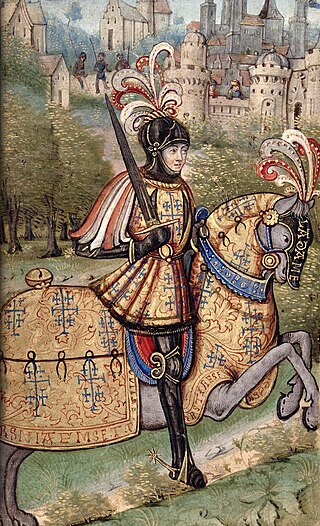
Philip II the Bold was Duke of Burgundy and jure uxoris Count of Flanders, Artois and Burgundy. He was the fourth and youngest son of King John II of France and Bonne of Luxembourg.

Margaret of York, also known by marriage as Margaret of Burgundy, was Duchess of Burgundy from 1468 to 1477 as the third wife of Charles the Bold, and after his death (1477) acted as a protector of the Burgundian State. She was a daughter of Richard, 3rd Duke of York, and of Cecily Neville, and the sister of two kings of England, Edward IV and Richard III. Born at Fotheringhay Castle, Northamptonshire, in the Kingdom of England, she died at Mechelen in the Low Countries.

Charles VII, called the Victorious or the Well-Served, was King of France from 1422 to his death in 1461. His reign saw the end of the Hundred Years' War and a de facto end of the English claims to the French throne.

Charles Martin, called the Bold, was the last duke of Burgundy from the House of Valois-Burgundy, ruling from 1467 to 1477. He was the only legitimate son of Philip the Good and his third wife, Isabella of Portugal. As heir and as ruler, Charles vied for power and influence with rivals such as his overlord, King Louis XI of France. In 1465 Charles led a successful revolt of Louis's vassals in the War of the Public Weal.

Isabella of Portugal was Duchess of Burgundy from 1430 to 1467 as the third wife of Duke Philip the Good. Their son was Charles the Bold, the last Valois Duke of Burgundy.

Philip III the Good ruled as Duke of Burgundy from 1419 until his death in 1467. He was a member of a cadet line of the Valois dynasty, to which all 15th-century kings of France belonged. During his reign, the Burgundian State reached the apex of its prosperity and prestige, and became a leading centre of the arts.

René II was Count of Vaudémont from 1470, Duke of Lorraine from 1473, and Duke of Bar from 1483 to 1508. He claimed the crown of the Kingdom of Naples and the County of Provence as the Duke of Calabria 1480–1493 and as King of Naples and Jerusalem 1493–1508. He succeeded his uncle John of Vaudémont as Count of Harcourt in 1473, exchanging it for the county of Aumale in 1495. He succeeded as Count of Guise in 1504.

Charolais is a historic region of France, named after the central town of Charolles, and located in today's Saône-et-Loire département, in Burgundy.

Marie of Anjou was Queen of France as the spouse of King Charles VII from 1422 to 1461. She served as regent and presided over the council of state several times during the absence of the king.

Yolande of Aragon was Duchess of Anjou and Countess of Provence by marriage, who acted as regent of Provence during the minority of her son. Yolande played a crucial role in the struggles between France and England, influencing events such as the financing of Joan of Arc's army in 1429 that helped tip the balance in favour of the French. She was also known as Yolanda de Aragón and Violant d'Aragó. Tradition holds that she commissioned the famous Rohan Hours.

Isabella of Bourbon, Countess of Charolais was the second wife of Charles the Bold, Count of Charolais and future Duke of Burgundy. She was a daughter of Charles I, Duke of Bourbon and Agnes of Burgundy, and the mother of Mary of Burgundy, heiress of Burgundy.

The Treaty of Arras was signed at Arras on 23 December 1482 by King Louis XI of France and Archduke Maximilian I of Habsburg as heir of the Burgundian Netherlands in the course of the Burgundian succession crisis.

The Lancastrian War was the third and final phase of the Hundred Years' War between England and France. It lasted from 1415, when Henry V of England invaded Normandy, to 1453, when the English were definitively defeated in Aquitaine. It followed a long period of peace from the end of the Caroline War in 1389. The phase is named after the House of Lancaster, the ruling house of the Kingdom of England, to which Henry V belonged.

The House of Valois-Burgundy, or the Younger House of Burgundy, was a noble French family deriving from the royal House of Valois. The Valois-Burgundy family ruled the Duchy of Burgundy from 1363 to 1482 and eventually came to rule vast lands including Artois, Flanders, Luxembourg, Hainault, the county palatine of Burgundy (Franche-Comté), and other lands through marriage, forming what is now known as the Burgundian State.

The Treaty of Senlis concerning the Burgundian succession was signed at Senlis, Oise on 23 May 1493 between Maximilian I of Habsburg and his son Philip "the Handsome", Archduke of Austria, and King Charles VIII of France.

Philippe Pot (1428–1493) was a Burgundian nobleman, military leader, and diplomat. He was the seigneur of La Roche and Thorey-sur-Ouche, a Knight of the Golden Fleece, and the Grand Seneschal of Burgundy.

Jean II de Lannoy or Jan van Lannoy (1410–1493), lord of Lannoy, Lys and Sébourg, was a nobleman from the County of Hainaut who played a prominent role in the politics of the Burgundian Netherlands.

Mathieu de Grailly or Mathieu de Foix was Count of Comminges between 1419 and 1443.

The War of the Burgundian Succession took place from 1477 to 1482, immediately following the Burgundian Wars. At stake was the partition of the Burgundian hereditary lands between the Kingdom of France and the House of Habsburg, after Duke Charles the Bold had perished in the Battle of Nancy on 5 January 1477.

The Burgundian State was a polity ruled by the Dukes of Burgundy from the late 14th to the late 15th centuries, and which ultimately comprised not only the Duchy and County of Burgundy but also the Burgundian Netherlands. The latter, acquired piecemeal over time and largely through inheritance, was, in fact, their principal source of wealth and prestige. The Dukes were members of the House of Valois-Burgundy, a cadet branch of the French royal House of Valois, and the complex of territories they ruled is sometimes referred to as Valois Burgundy. The term "Burgundian State" was coined by historians and was not in contemporary use; the polity remained a collection of separate duchies and counties in personal union under the Duke of Burgundy.



















